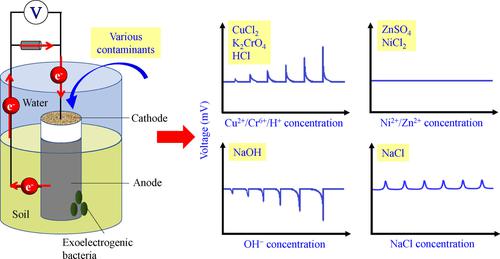当前位置:
X-MOL 学术
›
Electroanalysis
›
论文详情
Our official English website, www.x-mol.net, welcomes your feedback! (Note: you will need to create a separate account there.)
Distinct voltage signals of sediment microbial fuel cell sensors in sensing various contaminants
Electroanalysis ( IF 3 ) Pub Date : 2024-02-08 , DOI: 10.1002/elan.202300394 Huan Deng 1 , Tao Li 1 , Chenlu Li 1 , Cheng Han 2 , Yunbin Jiang 2 , Lixiang Chen 2 , Yaqing Xu 2 , Ying Li 2
Electroanalysis ( IF 3 ) Pub Date : 2024-02-08 , DOI: 10.1002/elan.202300394 Huan Deng 1 , Tao Li 1 , Chenlu Li 1 , Cheng Han 2 , Yunbin Jiang 2 , Lixiang Chen 2 , Yaqing Xu 2 , Ying Li 2
Affiliation

|
The sediment microbial fuel cell (SMFC) sensors using cathode as sensing element exhibited attractive prospects for online and in-situ monitoring. However, the sensing performance of SMFC sensors to different types of contaminants was seldom reported. In this study, SMFCs were constructed in stimulated wetland to sense five types of contaminants, including oxidative heavy metals (Cu2+ and Cr6+), non-oxidative heavy metals (Ni2+ and Zn2+), salt (NaCl), acid (HCl), and alkali (NaOH). The addition of Cu2+, Cr6+ or H+ triggered voltage peaks whereas the voltage dropped immediately following the addition of OH−. The addition of Ni2+ and Zn2+ did not trigger any obvious peaks. The NaCl solutions caused slight voltage peaks which were not increased with increasing concentrations. X-ray photoelectron spectroscopy (XPS) illustrated the reduction of Cu2+ and Cr6+ to elemental Cu and Cr3+ on the cathodic surface, indicating the contaminants that promote or inhibit electron consumption on cathode would cause voltage peaks or drops. The addition of heavy metals, OH− and NaCl significantly increased Simpson's diversity whereas Cu2+, Cr6+ and OH− significantly decreased the abundance of exoelectrogenic bacteria-associated genera in the top-layer soil. However, the influence of the contaminants on the abundance and diversity was attenuated in the middle and bottom layers, indicating that the exoelectrogenic bacteria could to some extent withstand these contaminants and guarantee the operation of the SMFC sensors.
中文翻译:

沉积物微生物燃料电池传感器在感测各种污染物时的不同电压信号
使用阴极作为传感元件的沉积物微生物燃料电池(SMFC)传感器在在线和原位监测方面展现出诱人的前景。然而,SMFC传感器对不同类型污染物的传感性能却鲜有报道。在本研究中,在人工湿地中构建SMFC来感测五种污染物,包括氧化性重金属(Cu 2+和Cr 6+)、非氧化性重金属(Ni 2+和Zn 2+)、盐(NaCl) 、酸(HCl)和碱(NaOH)。添加Cu 2+、Cr 6+或H +触发电压峰值,而添加OH -后电压立即下降。添加Ni 2+和Zn 2+没有引发任何明显的峰。氯化钠溶液引起轻微的电压峰值,但该电压峰值不会随着浓度的增加而增加。X射线光电子能谱(XPS)表明Cu 2+和Cr 6+在阴极表面还原成元素Cu和Cr 3+ ,表明促进或抑制阴极电子消耗的污染物会导致电压峰值或下降。重金属、OH -和NaCl的添加显着增加了辛普森多样性,而Cu 2+、Cr 6+和OH -显着降低了表层土壤中与产电细菌相关属的丰度。然而,污染物对丰度和多样性的影响在中层和底层减弱,表明产电细菌可以在一定程度上抵抗这些污染物并保证SMFC传感器的运行。
更新日期:2024-02-08
中文翻译:

沉积物微生物燃料电池传感器在感测各种污染物时的不同电压信号
使用阴极作为传感元件的沉积物微生物燃料电池(SMFC)传感器在在线和原位监测方面展现出诱人的前景。然而,SMFC传感器对不同类型污染物的传感性能却鲜有报道。在本研究中,在人工湿地中构建SMFC来感测五种污染物,包括氧化性重金属(Cu 2+和Cr 6+)、非氧化性重金属(Ni 2+和Zn 2+)、盐(NaCl) 、酸(HCl)和碱(NaOH)。添加Cu 2+、Cr 6+或H +触发电压峰值,而添加OH -后电压立即下降。添加Ni 2+和Zn 2+没有引发任何明显的峰。氯化钠溶液引起轻微的电压峰值,但该电压峰值不会随着浓度的增加而增加。X射线光电子能谱(XPS)表明Cu 2+和Cr 6+在阴极表面还原成元素Cu和Cr 3+ ,表明促进或抑制阴极电子消耗的污染物会导致电压峰值或下降。重金属、OH -和NaCl的添加显着增加了辛普森多样性,而Cu 2+、Cr 6+和OH -显着降低了表层土壤中与产电细菌相关属的丰度。然而,污染物对丰度和多样性的影响在中层和底层减弱,表明产电细菌可以在一定程度上抵抗这些污染物并保证SMFC传感器的运行。



























 京公网安备 11010802027423号
京公网安备 11010802027423号